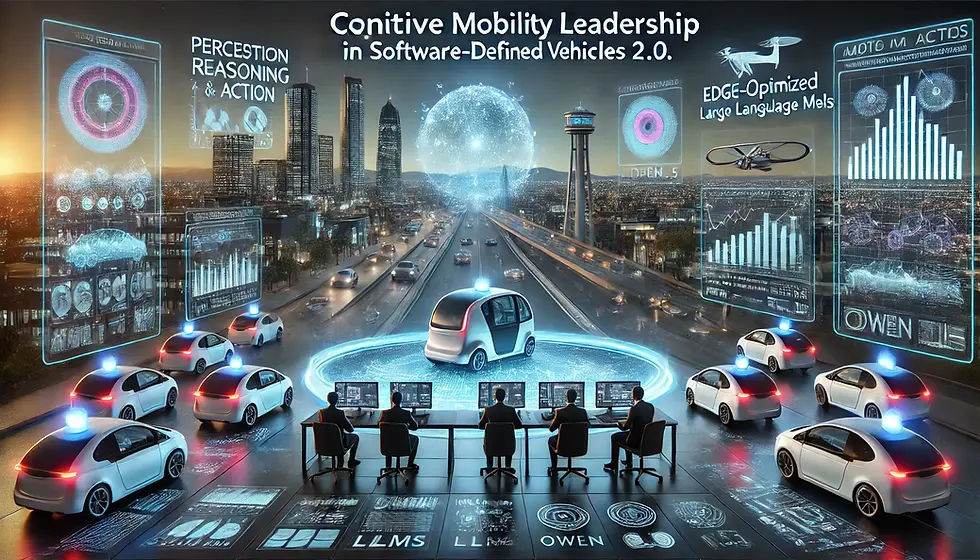Industry, Technology, and Innovation Trends for The Post COVID-19 Era
- Mahbubul Alam

- Dec 27, 2020
- 7 min read
Updated: Dec 13, 2022

Recently I was an invited speaker at IEEE Globecom 2020 Special Workshop on Communication and Networking Technologies for Responding to COVID-19. The speakers at this virtual workshop were all distinguished individuals and the topics covered were broad and insightful from contact tracing to smart devices, from detection & mitigation to data privacy & online lectures to AR/VR for smart health services, etc. It reminded me of a keynote speech by
Dr. Neeli Prasad, CTO of SmartAvatar B.V. at a virtual event that she said “society rightfully recognized the great contributions from our first responders, doctors, nurses, supply chain, logistics, supermarket workers, etc. but forgot to recognize or acknowledge the information and communication engineers who made internet and communication possible, without them, there won’t be any online collaboration, online school, telemedicine, social media, streaming services, e-commerce, etc.”

This special workshop reminded me of what drove me into engineering and entrepreneurship. The global economic downturn due to the pandemic COVID-19 outbreak acted as a catalyst to further amplify the adoption of new technologies and innovations above and beyond the pace, we got used to for the last two decades. Few things already seem very clear that platform firms like Amazon, Alibaba, Uber Eats, Zoom, etc. are dominating the markets even more. Companies will further accelerate their investment to conduct their business remotely over the internet to be more resilient to potential future lockdowns. My talk discussed about the industry, technology and innovation trends for the post-COVID-19 era.
My talk focused on the “Technology and Innovation Trends for the Post COVID-19 Era”. Here below is the abstract of my talk: Industry Trends Post COVID-19 Technology & Innovation.

The industry trends listed above were already in motion for the last few years. However, COVID-19 will accelerate these transformations. COVID-19 has pushed the government, companies, and society over the technology tipping point and transformed these industry trends forever.
This blog will address the role of artificial intelligence, robots, digital transformation, and how these trends will impact the industries such as healthcare, education, e-commerce, media & entertainment, connectivity, and Industry 4.0 AI-decision making.
Healthcare Post COVID-19
US healthcare spent was roughly $3.6 trillion in 2018 which makes it the highest per capita in the world with $11,172 per capita. Prior to the pandemic, 11% of the U.S.’s non-elderly population, roughly 30 million people, were uninsured or underinsured. It is estimated that due to COVID-19 shelter-in-place measures, which led to the economic lockdown, and the continuous lack of financial support from the government an additional 8 million people fell into poverty.
Telehealth Surge Under COVID-19
COVID-19 has caused a massive acceleration in the use of telehealth. Consumer adoption has skyrocketed as consumers replace their canceled healthcare visits with telehealth. In 2019, U.S. consumers’ use of telehealth made up 11%. However, now 46% of consumers are using telehealth services. Providers have rapidly scaled offerings and are seeing 50 to 175 times the number of patients via telehealth than they did before according to a McKinsey survey.
With the acceleration of consumer and provider adoption of telehealth and extension of telehealth beyond virtual urgent care, up to $250 billion of current US healthcare spending per year could be saved which is roughly 20% of Medicare, Medicaid, and commercial insurers spend. This saving alone will allow insurers to expand healthcare coverage to uninsured and underinsured citizens.
Higher Education Post COVID-19
COVID-19 changed the way of educating and I noticed it first-hand with my daughter studying at the University of Amsterdam, Netherlands. Many schools and higher educational institutes were caught off guard with the first lockdown coupled with stay-at-home or shelter-in-place orders from their state governors and city mayors during the Spring of 2020. Schools and teachers had to reinvent themselves overnight and learn on the fly how to conduct virtual classes effectively, interact efficiently with students through chat groups, video conferencing, scheduling video meetings, voting, distribute assignments, document sharing, etc. It tests the higher education institutions’ commitment to ensuring education for all its students and how to solve problems remotely.
Most students want to return to their onsite and in-person class, socialize with their classmates and friends but they also found it easier to online communicate and interact with tutors & professors. There is research out there that shows that average students retain 25% to 60% more material and require 40% to 60% less time when they learn online compared to only 8% to 10% in a classroom.
In short with online class students can learn at their own pace, going back and forth as many times they want, skip or accelerate through the course material as they please. Higher educational institutes have taken notice of it and in the future expect them to provide high-impact learning experience across hybrid mode a mix of onsite and online classes, placing educational quality above modality.
e-Commerce Post COVID-19
COVID-19 changed the face of the retail to a complete online Augmented Reality (AR) retail store with innovative ways to improve the shopping experience of customers, reduce the numbers of products customer returns and streamline the overall purchasing process.
Converse the shoe brand launched an AR app for iPhone called The Sampler that allows users to virtually try on shoes. Simply by pointing the camera towards their right foot, the user can see what the shoe would look like in real life. This also helps to streamline the purchasing process, as customers have the opportunity to buy a pair of shoes they like directly via the app.
Ikea has integrated artificial reality with their app named Place. Shoppers can now use the camera of their smartphone to virtually place different home furnishings into their surroundings. The program allows users to interact with the projected images and envisions how they would look in various spaces. This helps customers find the perfect piece of furniture without having to return items that they imagined would fit.
Warby Parker has a new update out for its iPhone app that uses Apple’s Face ID and AR tech to let customers virtually try on glasses in the app before they buy them. Warby Parker’s virtual try-on feature relies on Apple’s ARKit and True Depth features, so it’s only available on the iPhone X, XR, and XS phones.
Another example of smart use of AR technology is the DressingRoom app from Gap. Shoppers can provide the app with some basic information about their body. The program then creates a 3D model based on the user’s measurements. With this model in place, the user can virtually try on clothes to see how they look. This is just another way in which companies are making the margin of error smaller when it comes to online purchases.
Augmented Reality based online shopping will enable a personalized experience with an ability to test and explore products in ways that is similar to an in-person shopping experience.
Media & Entertainment Post COVID-19
Deepfake is synthetic data in which existing data, voice, image, and/or video is replaced with someone else’s likeness. Deepfake is also capable of generating realistic-looking images that even humans can’t recognize whether it’s real or not. Deepfake techniques are also used to generate synthetic data to balance algorithmically biased datasets for supervisory training of machine learning & deep learning models in order to improve overall model accuracy.
These People are NOT Real. These Images were Produced by StyleGAN
Cybercriminals are harnessing the power of this technology to reel in more victims. The thumbnail and heading make the victim really curious about the content of the video so they click through it “clickbait”. As soon as they navigate to the site, their computer is exposed to malware such as ransomware, keyloggers, or spyware. If they don’t have adequate cybersecurity in place, their computer is infected and they have to deal with the fallout.
On December 25, 2020, a hilarious digitally altered version of Queen Elizabeth’s annual Christmas speech was broadcast on the BBC and ITV.
The Deepfake version of Queen Elizabeth II took several swipes at members of the Royal family, and the Queen even danced in a Tik Tok routine. All of it was designed to warn of the ease of misinformation that could spread in the digital age.
Trust and verify what is genuine or what is not in the age of misinformation and disinformation media, it can be a serious threat to democratic values we take for granted and our way of life.
Connectivity Post COVID-19
A push towards a greater 5G investment and faster market adoption in developed economic countries will be mainly driven by the potential economic boom and contribution to countries GDP expected from 5G connectivity. 5G will create a value of $13.1 trillion in global sales activities by 2035.
Enhanced Mobile Broadband (eMBB) will extend the 5G coverage and capacity with licensed and unlicensed spectrum
Massive Machine Type Communication (mMTC) will scale Internet of Things (IoT) applications and improve the battery life of IoT devices. Mission Critical Applications enabled by Ultra Reliable Low Latency Communications (URLLC) will allow public safety, emergency response and other smart industrial safety critical use cases and services, for example, autonomous vehicles, remote telesurgery, wireless manufacturing control, etc. become commonplace.
5G and beyond 5G connectivity will not only create new jobs in every industry sector, it will also unleash new value streams that will help grow the global economy for everyone. Businesses across all industry sectors will benefit by leveraging the unique capabilities of 5G over 4G.
Artificial Intelligence (AI) Decision Making Post COVID-19
Many companies have adopted a data-driven approach for operational decision making as part of Industry 4.0. A data-driven approach can improve decisions but it requires the right processors “human” to get the most from it. However, to get the maximum value contained in the data, companies need to bring Artificial Intelligence (AI) into their workflow. Removing humans from workflows does not mean humans are obsolete, there are business decisions that depend on more than structured data e.g. strategy, creativity, corporate culture, empathy, emotion, and other forms of non-digital communication. This information is inaccessible to AI and extremely relevant to business decisions e.g. AI may determine that investment in digital marketing will result in the highest return on investment; however, a company may decide to slow down the growth for improving product quality.
AI-Driven Decision Making Combined with Human Judgement
Industry 5.0 refers to humans working alongside robots and smart machines. It is the age of Human-Machine Convergence. Industry 5.0 aims to support, not supersede, humans. COVID-19 proved the point that without human involvement manufacturing cannot function on its own. Industry 5.0 will automate the mundane tasks and relieve workers of physically demanding work so that workers can focus on creative craftmanship and concentrate on other tasks.
Industry 5.0 focuses on creating value beyond financial results. It seeks to improve the quality of life not only for the people involved but also for society as a whole.
Download my slides



Comments